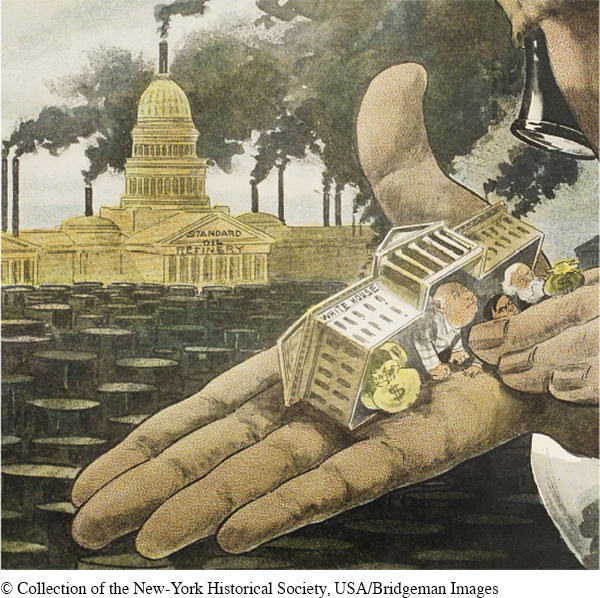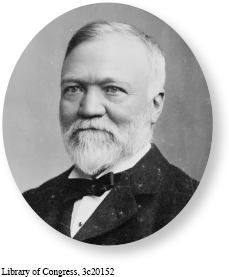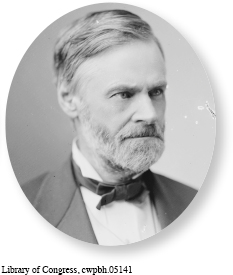Introduction to Chapter 16
16
Industrial America
1877–1900
WINDOW TO THE PAST
What a Funny Little Government, 1900
This image from a cartoon shows the nation’s capitol, where Congress meets, taken over by the Standard Oil Trust owned by John D. Rockefeller. Industrialization created large corporations, which through consolidation of functions and the elimination of competition yielded tremendous personal and national wealth. The artist is commenting on the power of big business to control politics. To discover more about what this primary source can show us, see Document 16.1.

LEARNING OBJECTIVES
After reading this chapter you should be able to:
Identify the factors leading to American industrialization and the impact of industrialization on business and the economy.
Explain popular doctrines guiding social and economic policy during the industrial age and describe prominent critiques of these ideas.
Describe new lifestyles that emerged from industrialization and how Americans reacted to anxieties about changing gender and racial roles that resulted.
Define the forces that constrained and influenced national politics in the late 1800s.
AMERICAN HISTORIES

In 1848 Will and Margaret Carnegie left Scotland and sailed to America, hoping to find a better life for themselves and their children. Once settled in Pittsburgh, Pennsylvania, the family went to work, including thirteen-year-old Andrew, who found a job in a textile mill. For $1.25 per week, he dipped spools into an oil bath and fired the factory furnace—tasks that left him nauseated by the smell of oil and frightened by the boiler. Nevertheless, like the hero of the rags-to-riches stories that were so popular in his era, Andrew Carnegie persevered, rising from poverty to great wealth through a series of jobs and clever investments. As a teenager, he worked in a telegraph office. A superintendent of the Pennsylvania Railroad Company noticed Andrew’s aptitude and made him his personal assistant and telegrapher. While in this position, Carnegie learned about the railroad industry and purchased stock in a sleeping car company; the returns from that investment tripled his annual salary. Carnegie then became a railroad superintendent in western Pennsylvania, and by the time he was thirty-five, he had grown wealthy from his investments in a wide variety of industries.
Andrew Carnegie eventually founded the greatest steel company in the world and became one of the wealthiest men of his time. He also became one of the era’s greatest philanthropists, fulfilling his sense of community obligation by giving away a great deal of his fortune.

John Sherman also believed in public service, but for him it would come through politics. Born in Lancaster, Ohio, in 1823, Sherman became a lawyer like his father, an Ohio Supreme Court judge. Like Carnegie, Sherman made shrewd investments that made him a wealthy man, although not on the same scale as Carnegie.
Sherman decided to enter politics and in 1854 won election from Ohio to the House of Representatives as a member of the newly created Republican Party. He rose up the leadership ranks as Republicans came to national power with the election of Abraham Lincoln to the presidency in 1860. From 1861 to 1896, Sherman held a variety of major political positions, including U.S. senator from Ohio and secretary of the treasury under President Rutherford B. Hayes. After his term as treasury secretary ended, he returned to the Senate and wielded power as one of the top Republican Party leaders. With his background as chair of the Senate Finance Committee and as secretary of the treasury, Sherman was the most respected Republican of his time in dealing with monetary and financial affairs. Sherman believed that government should encourage business. His most famous accomplishment, the Sherman Antitrust Act, which authorized the government to break up organizations that restrained competition, embodied this belief. It enacted limited reforms without harming powerful business interests.
The American histories of Andrew Carnegie and John Sherman began very differently. Both men played a prominent role in developing the government-business partnership that was crucial to the rapid industrialization of the United States. Carnegie’s organization and management skills helped shape the formation of large-scale business. At the same time, Sherman and his fellow lawmakers provided support for that enterprise, using the power of government to reduce risks for businessmen and to increase incentives for economic expansion. They often did so in ways that made politics more corrupt and made politicians less respected. Nevertheless, the public took politics seriously and turned out at the polls in great numbers. Corporate leaders joined with the clergy and writers to defend the established hierarchy of wealth and power. These businessmen used the doctrines of laissez-faire and Social Darwinism to justify their ruthless practices in the name of progress.
Industrialization and big business reshaped the nation. Railroads expanded national and international markets for American factory goods. Innovations and new inventions promoted business consolidation. Industrialization even brought changes to the agricultural South, all within the framework of racial segregation. Great fortunes were made, and the rich showcased their lavish lifestyles. Corporate consolidation also created a new middle class. The men of this group used their leisure to create new social and professional organizations while the women devoted more time to clubs and charitable associations.
Exploring American HistoriesPrinted Page 515
Exploring American Histories Value EditionPrinted Page 381
Chapter Timeline